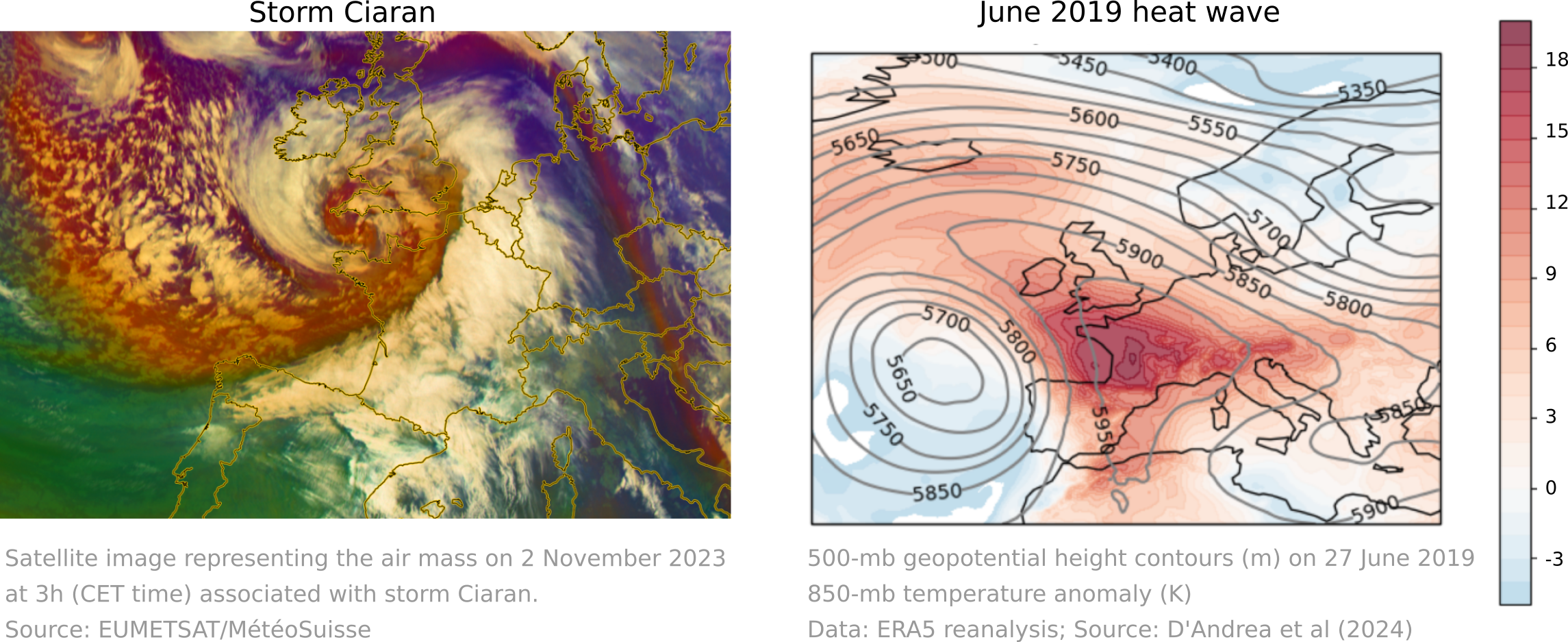Extratropical climate variability and extremes
In extratropical regions, atmospheric perturbations with
different spatial and time scales interact with each other. Our
objective is to study such interactions with a focus made on
processes leading to the formation of high-impact weather events
(wind storms, heavy precipitations, cold spells, heat waves,...)

One of the key question addressed by the scientific community
concerns the impact of climate change on high-impact weather events.
For instance, the faster warmings of the Arctic and the continents
relative to the ocean decrease horizontal thermal contrasts that
could influence mid-latitude cyclogenesis or jet streams. In
addition to climate change impact, our objective is to better
understand how different factors influence the behavior of
mid-latitude atmospheric perturbations like tropical convection, the
stratosphere and the ocean. To study processes involved in
mid-latitude atmospheric perturbations responsible for high-impact
weather extremes, a combination of various approaches is used. It
includes reanalysis data and a hierarchy of models ranging from most
simple models like quasi-geostrophic models to
intermediate-complexity models and more comprehensive models like
fully-coupled climate models used in CMIP exercises.
Since climate change becomes apparent in reanalyses datasets, it is
worth studying changes in atmospheric circulations and see if we can
attribute them to climate change. European heat waves are usually
triggered by atmospheric blockings which tend to warm the surface
via adiabatic warming due to subsidence and clear-sky radiative
forcing. The presence of a deep depression to the west may also help
transporting heat from low latitudes as was the case for the June
2019 heat wave (see right panel of the figure). Changes in such
circulations leading to extremes, like blockings or deep depressions
are studied in our team. However, extreme events being rare,
statistics are generally not robust when using reanalysis datasets
or even when analysing simulations of climate models that are not
long enough to study such rare events. Adequate tools need to be
developed to study rare events. For instance, rare event algorithms
are currently developed in our team to multiply the number of
simulated rare events in a model to get statistically robust
results. Machine learning algorithms are also used and developed to
get probabilist prediction of extreme events from the knowledge of
various meteorological variables.
Different tools and concepts have been recently developed to better
assess impacts of extreme weather events, in particular in the
context of climate change. The concept of compound events has been
recently introduced and refers to the combination of multiple
weather or climate drivers creating a societal or environmental
risk. It may correspond to interference between events of different
nature, successive events in time, or spatially distributed events
that aggregate to form a risk. Storylines is another rather recent
concept useful for adaptation to climate change as it allows a
better interaction between scientists and adaptation stakeholders.
Permanent Staff
F. Bouchet, F. D'Andrea, M. Ghil, A. Jézéquel, G. Lapeyre, F. Lott, G. Rivière, T. Roberts
PhD students, postdocs
J. André, M. Besson, V. Deshmukh, J. Lac, A. Lancelin, L. Mandonnet, L. Pauget, C.
Le Priol,

